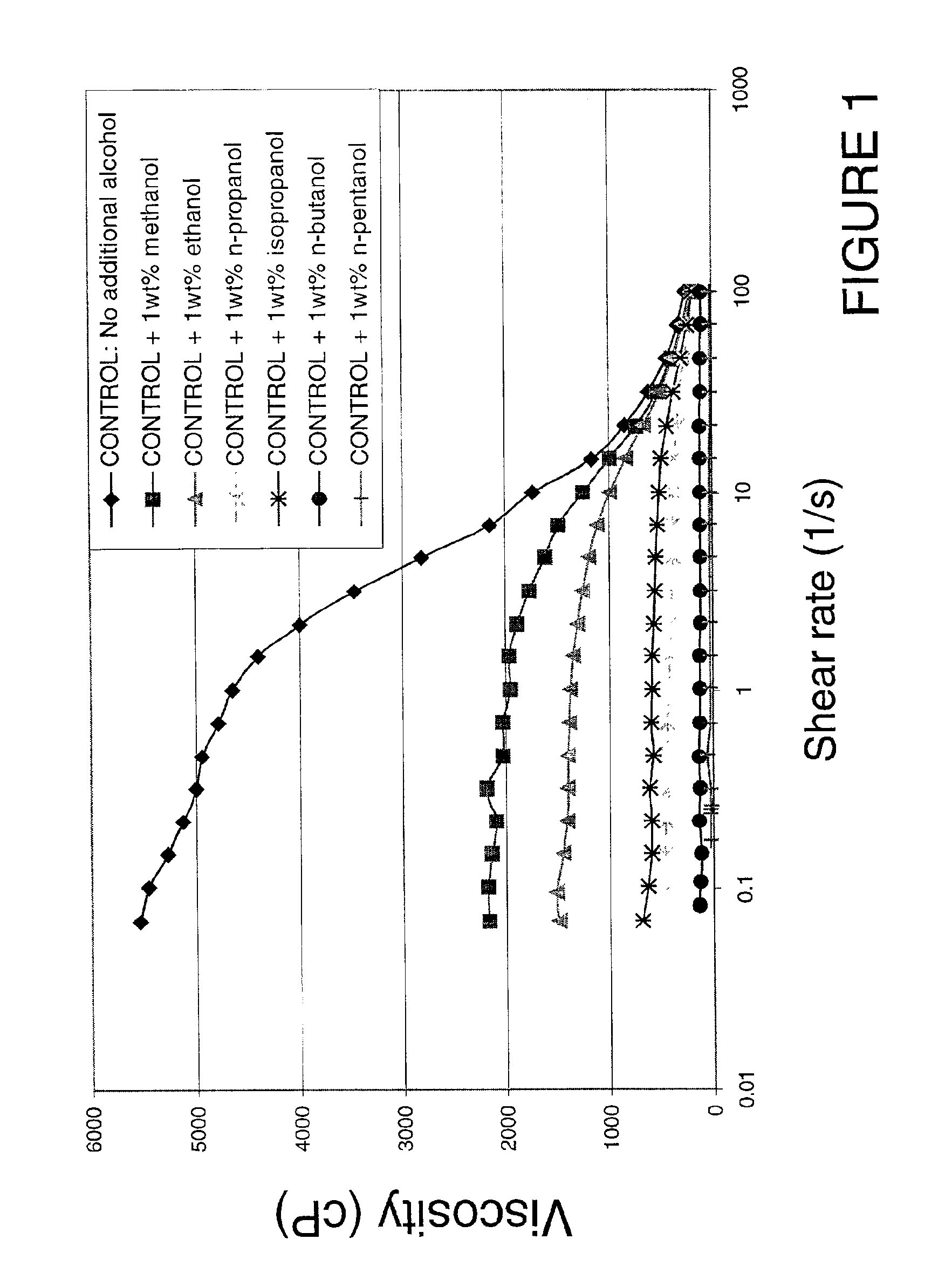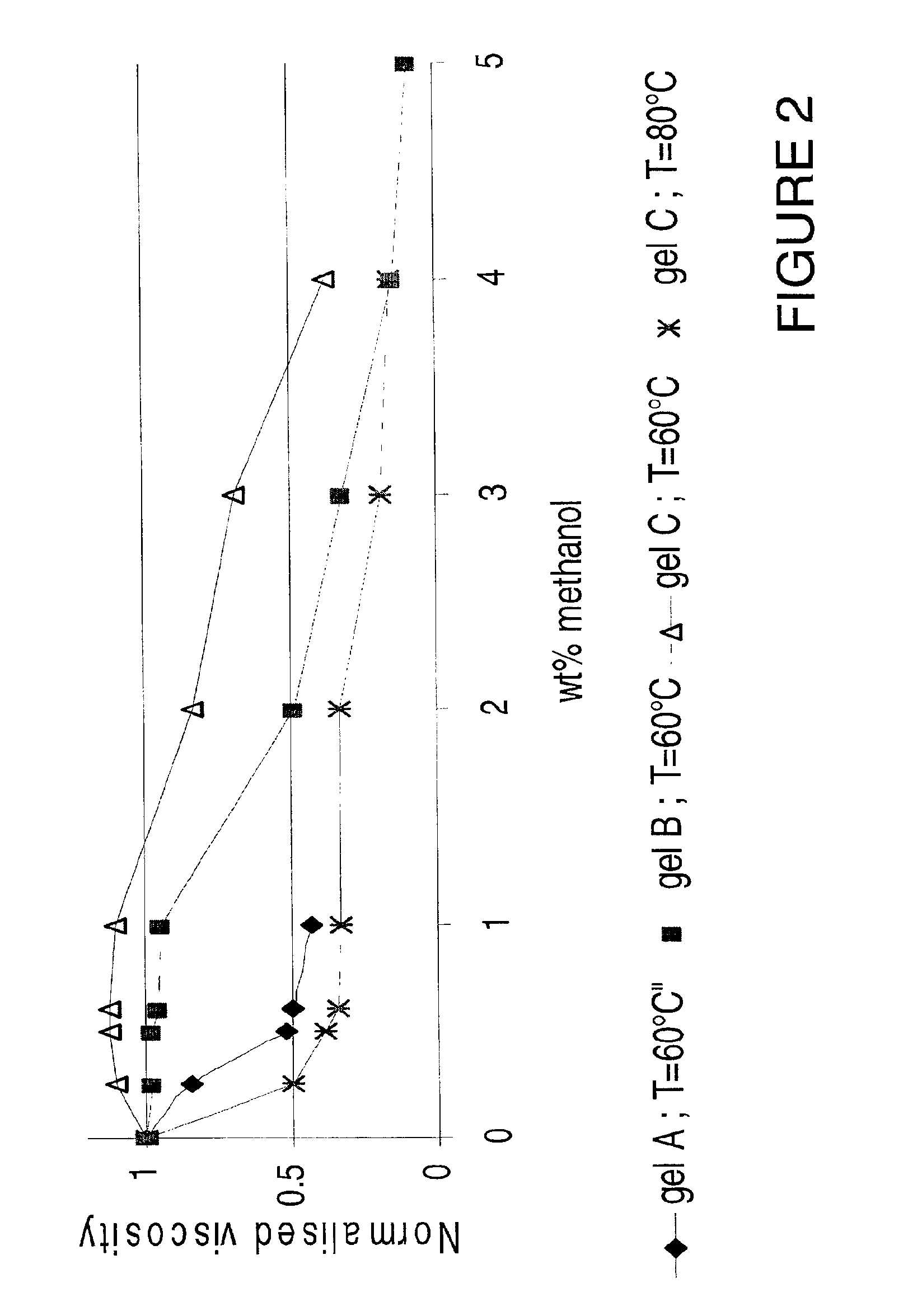Viscosity reduction of viscoelastic surfactant based fluids
a technology of viscoelastic surfactant and viscoelastic surfactant, which is applied in the field of viscoelastic surfactant (ves) fluid viscosity reduction, can solve the problems of reducing the formation permeability and the production, and achieve the effects of reducing the viscosity, enhancing the effectiveness of the main fluid, and improving or optimizing conditions
- Summary
- Abstract
- Description
- Claims
- Application Information
AI Technical Summary
Benefits of technology
Problems solved by technology
Method used
Image
Examples
example 2
Addition of Ether
[0054]The method relies on the use of an ester (R′COOR″) which has little effect on the rheology of the viscoelastic gel but which can decompose to generate alcohol (R″OH) at a concentration greater than or equal to the critical concentration required to break the gel, where R′ and R″ are aromatic, saturated, or unsaturated, hydrocarbon chains.
R′COOR″+H2O→R′COOH+R″OH
[0055]Since some organic acids are also efficient to break a gel comprising a VES (see example 3), addition of ester can indeed be very effective—provided the hydrolysis occurs at appropriate time. A similar effect can be achieved by using the appropriate dibasic or tribasic ester.
[0056]FIG. 3 shows the effect of adding various methyl diesters to gel B defined in example 1. In contrast to the more hydrophobic diesters (dimethyl glutarate, dimethyl adipate, dimethyl diethyl malonate and dimethyl azelate), the more hydrophilic esters (dimethyl itaconate, dimethyl malonate, dimethyl malate and dimethyl oxal...
example 3
Addition of a Salt of an Organic Acid
[0058]Some organic acids are efficient gel breaker. The acid can be provided encapsulated or as a salt. Then, under acidic conditions, the following reaction occurs:
RCOO−+H+→RCOOH
[0059]The salt shall be selected so that RCOO− has little or no effect as an effective counterion in the viscoelastic gel. Examples of suitable anions are:[0060]salicylate anion / salicylic acid: 2-(HO)C6H4COO−+H+→2-(HO)C6H4COOH[0061]adipate anion / adipic acid: −OOC(CH2)4COO−+2H+→HOOC(CH2)4COOH[0062]versatate anion / versatic acid: C9H19COO−+H+→C9H19COOH[0063]glutarate anion / glutaric acid: −OOC(CH2)3COO−+2H+→HOOC(CH2)3COOH
[0064]In this example, the initial fluid pH is greater than the pKa of the carboxylic acid so that the concentration of RCOO− is greater than the concentration of RCOOH. At the appropriate time, lower pH conditions are generated so that the concentration of RCOOH increases and becomes greater than the concentration of RCOO−. Lower pH conditions can be genera...
example 4
Addition of Organic Sulfate Salts
[0069]Long chain alcohols can be generated by the acid hydrolysis of organic sulfate salts such as (i) R—OSO3X, where R is a saturated linear hydrocarbon chain and X is an alkali metal (e.g. sodium lauryl sulfate, C12H25SO4Na) or (ii) RO(CH2CH2O)nSO4X (alcohol ether sulfate) where R is a saturated linear hydrocarbon chain, typically with 10-15 carbon atoms, n is in the range 2-10 and X is typically sodium, magnesium or ammonium.
[0070]Acid hydrolysis of R—OSO3X or RO(CH2CH2O)nSO4X at elevated temperatures (typically >50° C.) releases sulphuric acid which catalyses the hydrolysis, e.g. under acid conditions, R—OSO3X+H2O→ROH+H2SO4. Certain concentrations of alkyl sulfates (e.g. sodium lauryl sulfate, C12H25SO4Na) or alcohol ether sulfates (e.g. C14H29O(CH2CH2O)2-3SO4NH4) are effective co-surfactants in viscoelastic surfactant gelling compositions where the viscoelastic surfactant component is cationic, e.g. erucyl methyl bis(2-hydroxyethyl) ammonium chl...
PUM
| Property | Measurement | Unit |
|---|---|---|
| Fraction | aaaaa | aaaaa |
| Fraction | aaaaa | aaaaa |
| Fraction | aaaaa | aaaaa |
Abstract
Description
Claims
Application Information
 Login to View More
Login to View More - R&D
- Intellectual Property
- Life Sciences
- Materials
- Tech Scout
- Unparalleled Data Quality
- Higher Quality Content
- 60% Fewer Hallucinations
Browse by: Latest US Patents, China's latest patents, Technical Efficacy Thesaurus, Application Domain, Technology Topic, Popular Technical Reports.
© 2025 PatSnap. All rights reserved.Legal|Privacy policy|Modern Slavery Act Transparency Statement|Sitemap|About US| Contact US: help@patsnap.com



